
* Following work by the Mil helicopter design bureau in the last half of the 1960s, the Soviet Union's first dedicated helicopter gunship, the "Mi-24", went into service in the 1970s. It would serve an important role in the Soviet war in Afghanistan, and become a symbol of Soviet military power.
* The Soviets used their Mi-8 "Hip" transport helicopter as a heavy gunship, in somewhat the same way that the US Army used the Bell UH-1 "Huey" as a gunship in Vietnam. However, the Americans moved to a dedicated attack helicopter, the Bell AH-1 "Cobra", and found it more survivable.
Mikhail Mil, head of the Soviet Mil helicopter design bureau, was very interested in the idea of a purpose-designed attack helicopter. His organization rolled out a mockup in 1966 to show the authorities the possibilities; the brass was suitably impressed and gave the go-ahead for prototype development in the spring of 1967. A team at the Mil design bureau under V.A. Kuznetsov conducted the design work, with the effort closely monitored by Mil, and then, after Mil's death from cancer on 31 January 1970, by his successor, Marat Timoschenko. Mil did live long enough to see the first of three prototypes of the "V-24", as it was then designated, rolled out in June 1969. The initial prototype performed its first untethered flight on 19 September 1969.
The new machine had very little resemblance to the 1966 mockup, though many of the significant concepts explored in the mockup were implemented. The V-24 was based on the Mi-8's engine and transmission system, but had a new fuselage with a narrower frontal cross-section, as well as armor protection.
Following the manufacture of ten preproduction machines, the full production "Mi-24A" was introduced into service in 1973, being observed by Western intelligence the following year. NATO gave it the reporting name "Hind-A". Once information came to light about the pre-production machines, NATO confusingly assigned them the reporting name of "Hind-B". A "Hind-C" trainer was also built, with dual controls and no armament; and a special modification, the "A-10", stripped of all nonessentials, was used in 1975 by a female crew to set a number of world records for helicopter speed, climb, and altitude.
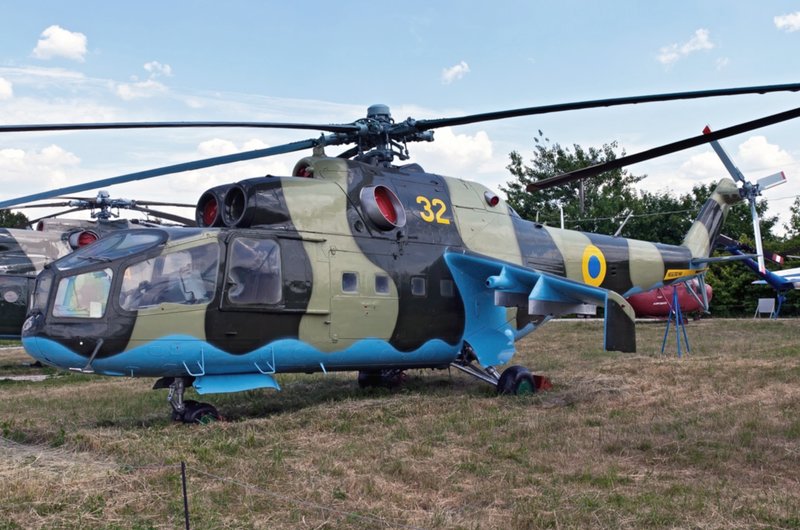
* The Mi-24A featured:
The primary external difference between the preproduction Hind-B and full production Hind-A machines was that the Hind-B had flat removeable stub wings, while the fixed stub wings of the Hind-A had a 12-degree anhedral droop. The anhedral was added to improve yaw stability. The stub wings were fitted with a total of four stores pylons, each capable of carrying an unguided rocket pod, an antitank missile, or other store, plus wingtip launch rails that could each carry two radio-controlled 9M17M Falanga-M (NATO AT-2 Swatter) antitank missiles. There was also a gun camera in the left stub wing.
In addition to three crewmen -- consisting of gunner, pilot, and navigator in an armored "greenhouse"-style cockpit -- the Mi-24A could carry a squad of eight soldiers, seated in two back-to-back rows of four. In principle, this meant that the Hind-A could carry a squad of troops into battle and then provide fire support, making it less a "flying tank" than a "flying infantry combat vehicle", and in fact the windows included firing ports for the soldiers' assault rifles, much like an infantry combat vehicle. The machine could also carry four stretchers with an attendant. In practice, the Hind would rarely be used to carry infantry or wounded. However, the cargolift capability proved handy in that it allowed the gunship to self-deploy to a field base, carrying its own service crew and kit. The Mi-24A was pressurized for protection against biological and chemical agents.
The Hind-A was quickly replaced by improved Mi-24 variants, as described below. Only about 240 Hind-As were built in all. Small numbers were exported to four Soviet client states, including Afghanistan, Algeria, Libya, and Vietnam. Export variants of the Hind are discussed in the next chapter.
BACK_TO_TOP* The Hind-A suffered from some drawbacks in service. Firepower was inadequate and even though the Hind-A's cockpit featured a large area of glass, it provided a surprisingly poor field of view, as well as poor crew protection. After building a limited set of "Mi-24B" prototypes that were essentially Mi-24As with improved weapons and sensors, the Mil OKB decided to abandon that line of work and move on to a more drastic modification, the "Mi-24D Hind-D".
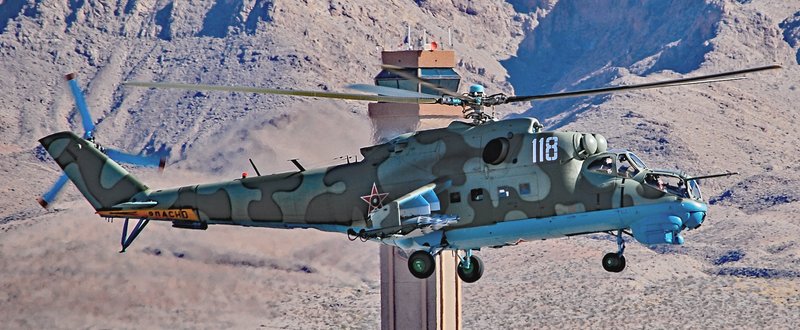
The Hind-D featured a completely revised forward fuselage arrangement that reduced the crew from three to two and featured separate, heavily armored cockpits with thick armor-glass canopies. The new variant retained the rest of the structure of the Hind-A, including the TV3-117 turboshafts and the ability to carry passengers. A gunner / weapons operator sat in the forward cockpit of the Hind-D, climbing in and out through a panel on the left side that hinged upward. The pilot sat in the stepped-up rear cockpit, entering and leaving through a car-style door on the right side that opened towards the rear. Helicopter gunships tend to be ugly, brutish machines -- but if there were a mean and ugly competition, the Mi-24D would be heavily favored to win it. The ugliness didn't matter; the revised fuselage cut down the frontal area of the gunship, reducing its vulnerability and improving performance.
The rotor system was reinforced with titanium to allow it to withstand 20-millimeter cannon hits. Armament was improved to a four-barreled Yakoushev-Borzov YakB-12.7 12.7-millimeter machine gun, with a rate of fire of about 4,000 rounds per minute and an ammunition store of 1,470 rounds. The gun was fitted in a nose turret with a traverse from 15 degrees up to 60 degrees down, and 70 degrees to either side. The gun could also be fixed forward and fired by the pilot through a gunsight. The stub wings were reinforced to handle heavier weapons loads, and the pylons were "wet" to allow carriage of external tanks.
A large air data boom was fitted in front of the gunship to provide inputs for accurate sighting of weapons in sidewinds and during maneuvers. A turret containing an electro-optical sight, with low light level TV (L3TV) and a forward-looking infrared (FLIR) imager, plus a laser rangefinder, was mounted behind and to the right of the gun turret, while a pod carrying an AT-2 missile control system was mounted behind and to the left.
The Falanga-M AT-2 missile was upgraded to the Falanga-P AT-2 variant, with range increased from three to four kilometers (1.85 to 2.5 miles) and a semi-automatic guidance system. While the operator had to "fly" the earlier model of the AT-2 all the way to the target, all he had to do with the new version was keep the crosshairs of his sight on the target. The kill ratio increased from about 30% to over 80%.
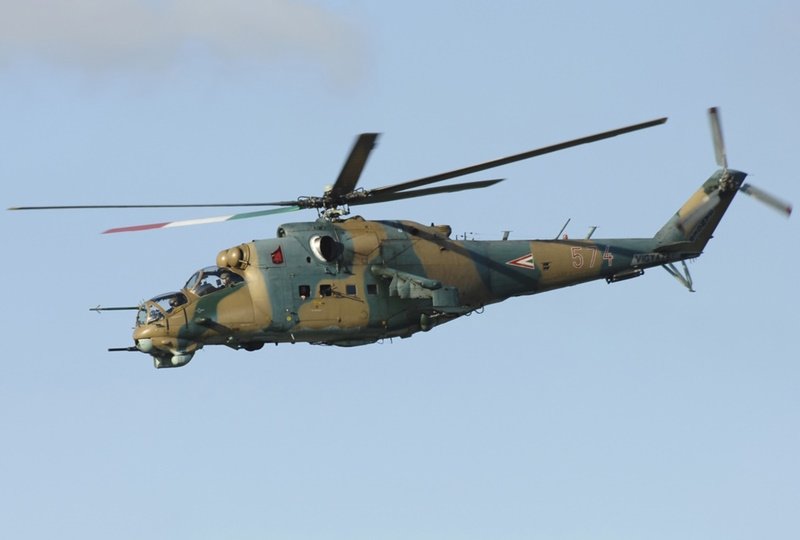
Other changes included longer nose landing gear to provide additional clearance for the sensors, and repositioning of the gun camera from the wingroot to the wingtip, since rocket launches had fouled the camera lens in its original position.
___________________________________________________________________
MIL MI-24D HIND-D:
___________________________________________________________________
main rotor diameter:
17.3 meters (56 feet 9 inches)
tail rotor diameter:
3.91 meters (12 feet 20 inches)
fuselage length:
17.51 meters (57 feet 6 inches)
footprint length:
19.79 meters (64 feet 11 inches)
height (tail rotor):
6.5 meters (21 feet 4 inches)
height (rotor head):
4.44 meters (14 feet 7 inches)
empty weight:
8,200 kilograms (18,080 pounds)
max loaded weight:
12,000 kilograms (26,450 pounds)
maximum speed:
335 KPH (208 MPH / 180 KT)
service ceiling:
4,500 meters (14,765 feet)
range, internal fuel:
750 kilometers (465 MI / 405 NMI)
___________________________________________________________________
Two Mi-24D prototypes were built in 1972 as conversions of early Mi-24As. These machines retained the right-side tail rotor, though all production Hind-Ds had left-side tail rotors. Production began in 1973, with about 550 machines built to end of manufacture in 1977.
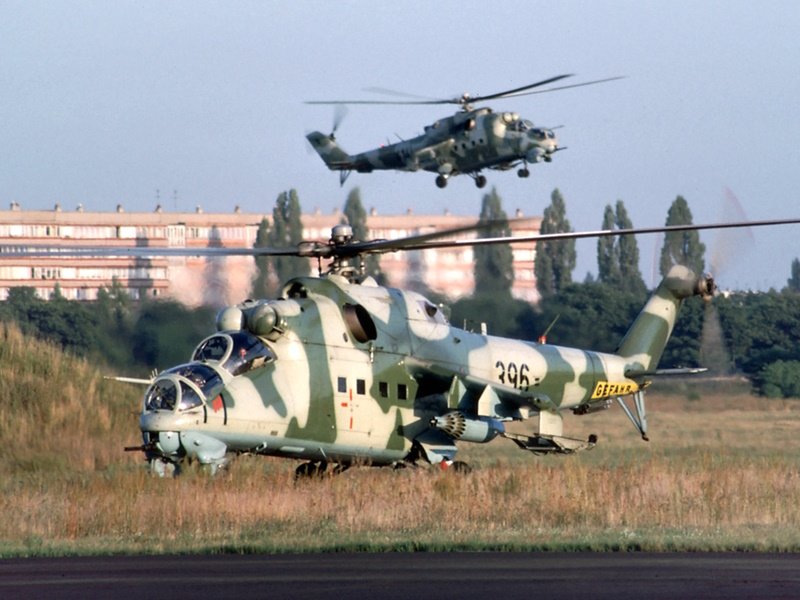
Operational experience, particularly with Soviet forces in Afghanistan, demonstrated the need for improved defensive countermeasures. A kit including a radar warning receiver (RWR), chaff-flare dispensers, an infrared jammer, and boxy exhaust suppressors was retrofitted to many Mi-24Ds. Dusty conditions in that theatre also led to the retrofit of domelike engine intake anti-dust filters ("PZU" in their Russian acronym).
BACK_TO_TOP* The Mi-24D was replaced in production by the improved "Mi-24V", which became known as the "Hind-E". The primary rationale for the Hind-E was support of the advanced 9M114 Sturm-V (NATO AT-6 Spiral) tube-launched antitank missile, faster and with longer range than the AT-2, and with a kill ratio of over 90%.
In fact, the earlier Hind-D was originally supposed to have carried the AT-6 and was to be designated the Mi-24V, but delays in the missile development program meant that it went into production as an interim type using the AT-2. The "V" code was used since it is the third character in the Cyrillic alphabet, following "A" and "B". The "D" code is actually the fifth character in the alphabet; the Soviets didn't like to use the fourth letter, "G", in designations, because crews were likely to remark that it stood for "Gavno (Shit)".
The initial prototype of the Hind-E, a conversion of a production Hind-D, was rolled out in 1973, and the new variant went into production in 1976. About 1,400 were built over the next decade.
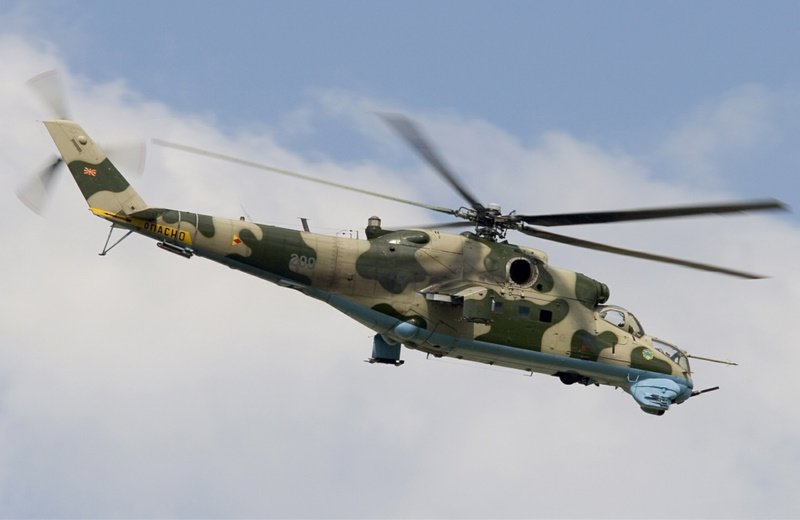
The Hind-E featured a new missile-control pod, and the pilot's cockpit was equipped with a head-up display (HUD) in the place of the fixed gunsight. One of the interesting features of the Hind-E was a secondary set of flight controls added to the gunner's cockpit, with the controls folded out of sight in normal operation. The secondary controls could be brought out in an emergency or for training purposes. Other changes included uprated turboshafts for better "hot & high" operation, improved avionics, and PZU engine intake filters as standard. Late production Hind-Es were also fitted with a countermeasures suite similar to that retrofitted to Hind-Ds. It was difficult to tell a Hind-E from a Hind-D if the machine wasn't carrying antitank missiles, but one giveaway was that the Hind-E's missile control pod had a black dielectric nose while the Hind-D's didn't.
A number of Hind-Es were fitted as trainers with full dual controls and designated "Mi-24VU". They were apparently not used in Soviet service, having been manufactured on request from India, an enthusiastic user of the Hind.
* The "Mi-24P Hind-F" was a further evolution of the Hind, with improved avionics and the nose turret replaced by a two-barreled 30-millimeter GSh-30K cannon in a fairing on the right side of the machine, with 750 rounds of ammunition. The "P" stood for "pushechniy (cannon-armed)".
The 30-millimeter cannon was adopted after experience in Afghanistan showed that some targets were too hard for the 12.7-millimeter gun, but weren't worth expenditure of rockets. Interim experiments investigated the use of cannon pods carried on the stub wings, but that fit did not prove satisfactory. The 30-millimeter cannon was too big to reasonably mount in a turret, so it was fitted to the side of the machine and aimed by pointing the entire helicopter at the target. Airframe reinforcements were added to handle the recoil. The Hind-F went into production in 1981, with 620 built to end of production in 1989.
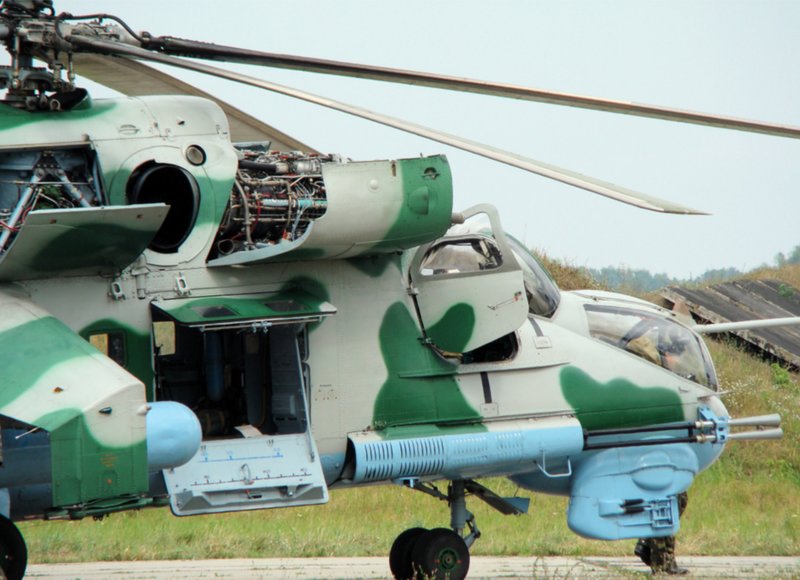
The Soviets were pleased with the big cannon mounted on the Hind-F, but found its fixed mount inconvenient. As a result, in 1985 they designed a compromise, the "Mi-24VP", with a twin-barreled 23-millimeter GSh-23L cannon in a nose turret. The new weapons fit turned out to be closer to the ideal, but by this time the USSR was running out of steam, and only 25 Mi-24VPs were built. The Mi24VP was never given a NATO reporting name. By the year 2000, the Hind-E and Hind-F had completely replaced the Hind-D with its comparatively ineffectual AT-2 ATGM in Russian service.
* Several special-purpose variants of the Hind were produced in small numbers. The "Mi-24R Hind-G1" was an all but unique battlefield nuclear-biological-chemical (NBC) reconnaissance machine. It was essentially a Hind-E fitted with an air-sampling system in the nose to check for airborne chemical, biological, or radiological contaminants; and "excavators", or "clutching hands" ground-sampling gear, attached to the wingtips to allow it to pick up soil samples for analysis.
The Hind-G1 had a flare dispenser to mark out dangerous areas. The targeting pod for antitank missiles was deleted, but it retained the nose turret with the 12.7 millimeter Gatling gun and was seen with unguided munitions on its wing pylons, so it did retain some combat capability.
The Hind-G1 carried a crew of four, including gunner, pilot, flight engineer, and analyst. Although the crew accommodation was designed to seal out chemical or radiological contaminants, normal procedure required that all the crew wear full protective gear. The machine could perform some onboard analysis and relay the results to a command center over a radio datalink. The Hind-G1 was often seen in videos taken during the Chernobyl nuclear reactor disaster.
The Hind-G1 prototype was converted from a Hind-E in 1978, and followed by about 150 production machines, built between 1983 and 1989. In 1989, some of the Hind-G1s were upgraded with improved communications and other systems.
Another specialized variant was the "Mi-24K Hind-G2", used for artillery spotting -- the "K" standing for "Korrectivrovchik (Correction)". It was fitted with a big oblique camera in the passenger cabin, and featured a camera housing under the nose in the place of the targeting gear. Like the Hind-G1, the Hind-G2 had no capability to launch guided antitank missiles and no targeting pod, but it retained the machine gun turret and the ability to carry dumb munitions. The prototype was rolled out in 1979, and 163 Hind-G2s were built from 1983 to 1989.
* Among the more interesting Hind subvariants were two Hind-Fs modified for internal security and search-and-rescue operations for the Russian Interior Ministry and redesignated "Mi-24PS".
The first machine retained the 30-millimeter cannon, but the nose system was completely rearranged, with a FLIR video turret; a searchlight; and a loudspeaker system that looked something like a scrub-brush from a distance. In addition, it carried a weather radar and improved communications gear, including a satellite communications link. It had a rescue hoist, as well as external footrests to allow up to four Interior Ministry police to crawl outside and then rappel down to the ground at once.
A second prototype was displayed at the Moscow air show in 1995. It was similar to the first, but all armament was deleted, and the stub wings were cut down to only one pylon on each side, presumably to carry external fuel tanks. The machine was painted in a spiffy white-with-blue civilian color scheme. The Mi-24PS does not appear to have been used operationally.
* There have also been a number of experimental Hind modifications:
* By the late 1970s, the Hind was in widespread use by the Soviet military and client states. Crews called it the "Krocodil (Crocodile)". The machine became a well-recognized symbol of Soviet power, something like a real-world "STAR WARS Darth Vader Imperial Tie Fighter" for those in the West who saw the Soviet Union as the "Evil Empire". The Hind was qualified for a wide range of stores, including:
Hinds were evaluated with heat-seeking air-to-air missiles (AAM). The evaluations left something to be desired, but some Hinds were fielded with R-60 ("AA-8 Aphid") AAMs. In fact, after a rash German youngster named Matthias Rust landed a light civil aircraft on Red Square on 28 May 1987, Hinds armed with Aphids were assigned to the air defense role to deal with such intruders, and forced several of them to land on Soviet airfields.
* That was the least of the Hind's military service. It played a major role in the war in Afghanistan, with Hinds supplied to the Afghan government in April 1979 to deal with Mujahedin Islamic guerrillas. The Afghan pilots were well-trained and made effective use of their machines, but the Mujahedin were not soft targets. They shot down the first Hind to be lost in action on 30 May 1979.
The situation in Afghanistan grew worse and on 25 December 1979 Soviet troops were committed to the war, an action that would prove a major blunder. The Red Army found itself involved in a guerrilla war in a country where the rugged terrain favored the locals, who were enthusiastic, competent, and cruel fighters. The Hind seemed like an excellent weapon to help deal with the Mujahedin. Soviet field commanders begged for all the Hinds they could get.
After a nasty learning curve at the hands of the Mujahedin, Hind pilots learned to be dangerous and cruel themselves, and the Mujahedin called the Hind the "Shaitan-Arba (Satan's Chariot)". In one case, a Hind pilot managed to rescue a company of infantry even when he was out of ammunition simply by maneuvering aggressively at the Mujahedin and scaring them off. Ground troops really liked the Crocodile, since it could stay on the battlefield and provide fire as needed, while "fast mover" strike jets could only stay for a short time before they would have to head back to base to refuel.
The Hind's favored munition was the 80-millimeter rocket, the 57-millimeter rocket having proven too light to be effective. As mentioned, the 23- millimeter gun pod was also popular. The Hind could carry ten 100-kilogram (220-pound) iron bombs for attacks on strongpoints, while harder targets could be dealt with using a load of four 250-kilogram (550-pound) or two 500-kilogram (1,100-pound) iron bombs. Some Hind crews became expert "snipers" in dropping or tossing bombs precisely on targets. Fuel-air explosive bombs were also used in a few instances, though initially crews underestimated the sheer blast force of such weapons and were caught by shockwaves that rattled their teeth.
Combat experience quickly demonstrated that carrying a squad of troops in a Hind wasn't a good idea. The gunship crews found the soldiers a worry and a distraction while being shot at, and preferred to fly lightly loaded anyway, all the more so because they operated from high ground altitudes in Afghanistan. Hind troop compartment armor was often deleted to reduce weight. Troops were carried in Hip helicopters, with the Hinds providing fire support.
It did prove useful to carry a technician in the Hind's crew compartment, handling a light machine gun in a window port. That gave the Hind some ability to "cover its ass" while exiting a target area. In some cases a light machine gun was fitted on both sides to allow the technician to move from one side to the other without having to take the machine gun with him. Trying to shift a machine gun from one side of a helicopter to another while maneuvering under fire was not merely clumsy and inconvenient, it was an invitation to lethal accidents.
This weapons fit still left the gunship blind to the direct rear, and the OKB experimented with fitting a machine gun in the back of the fuselage, with the gunner reaching the gun through a narrow crawlway. The experiment was very unsuccessful, since the space was full of engine exhaust fumes and otherwise unbearable, and during a demonstration an overweight Soviet general got stuck in the crawlway. Operational Hinds were retrofitted with rear-view mirrors to help the pilot spot threats and take evasive action.
* The Hinds not only protected helicopter troop assaults and supported ground actions, they also provided cover for convoys, using rockets with flechette warheads to drive off Mujahedin ambushes; performed strikes on predesignated targets; and engaged in "hunter-killer" sweeps. The hunter-killers operated in pairs at minimum, more often groups of four or eight, to provide mutual fire support. They used tactics developed during the Great Patriotic War against Hitler, such as the "Wheel of Death", with the gunships turning in a wide circle to ensure that one was always chewing up the target area. The Mujahedin learned to move mostly at night to avoid the gunships, and in response the Soviets trained their Hind crews in night-fighting, dropping parachute flares to illuminate suspicious targets for attack.
Gunship attrition rates were high. The environment itself was rough on the machines, since it was dusty and often hot; the dustiness led to the development of the PZU intake filters. Of course, the Mujahedin fought back whenever they could. Their primary air-defense weapons early in the war were heavy machine guns and anti-aircraft cannon, though they found out that anything smaller than a 23-millimeter gun generally didn't do much more than annoy a Hind. Then the Americans began to supply the Mujahedin with "Stinger" shoulder-launched, heat-seeking surface-to-air missiles (SAM), and the situation got considerably worse, helping drive the effort to fit improved defensive countermeasures to the Hinds.
Hinds were also used to shield jet transports flying in and out of Kabul from Stingers. The gunships carried flares to blind the missiles, and were under orders to try to take the hit from the missile themselves if worst came to worst. The crews called themselves "Mandatory Matsurovs", after a hero of the Great Patriotic War who threw himself across a Nazi machine gun to let his comrades break through.
Hind crews led a rough life in general. They carried AK-74 assault rifles with collapsible stocks to give them a better chance of survival if forced down. They got rid of some of the food and water in the survival kit to make room for more rifle ammunition and grenades, since dying of starvation or thirst was the least of their worries if they were forced down in Mujahedin territory.
In such a kill-or-be-killed environment, Hind crews acquired a certain edge. Their own brass called them "flying hooligans"; in the US military, they would have been called "cowboys" or "hairy-assed". Early in the war, Marat Timoschenko had visited Afghanistan to see what the troops thought of his helicopters, and gunship crews put on spectacular displays for him. They even demonstrated maneuvers, such as barrel rolls, that the design engineers considered impossible. An astounded Dr. Timoschenko had to comment: "I thought I knew what my helicopters could do, now I'm not so sure!"
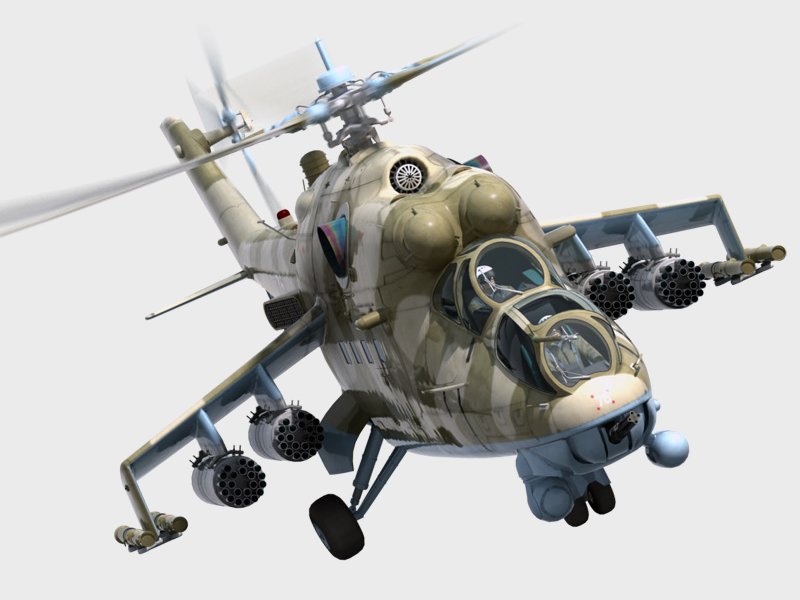
Despite continuous improvements in operational procedures and the skills of gunship crews, none of that made much difference in a war whose political and military basis rested on quicksand. Afghanistan was draining the USSR, and there was no end in sight; better to pull out and let the Afghans kill each other. By 1987, the Soviets were working to extricate themselves from the war, though as with everything else in Afghanistan, it wasn't easy. An Mi-24 was shot down on the night of 2 February 1989, with both crewmen killed. It was the last of 333 Soviet Hinds lost in almost ten years of grinding war.
BACK_TO_TOP